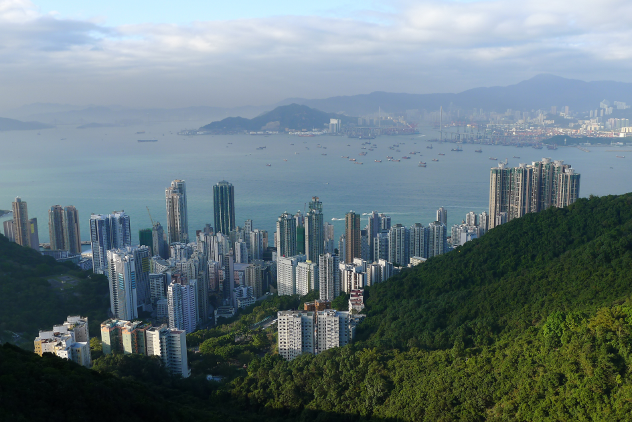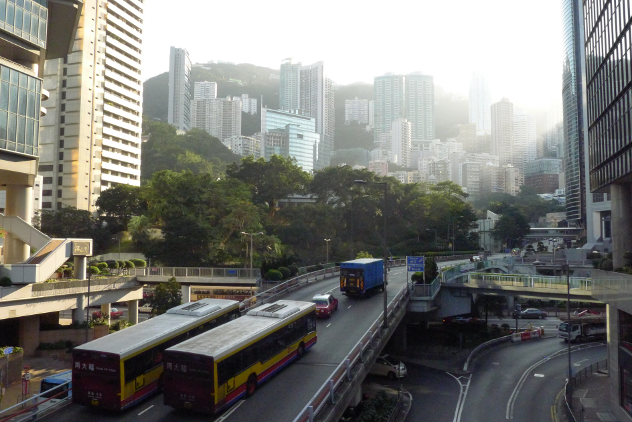Place: Pilar Quintana
We asked Pilar Quintana to write about an especially intriguing or pleasant place she'd visited. She sent us this brief text on Hong Kong, one of her favorite cities.
In places with very clean air, like Antarctica or the mountains, visibility can reach up to seventy or even a hundred kilometers. The norm, let’s say in a medium-sized city on a clear day, is twenty kilometers. In Hong Kong, during a good part of the year, visibility is less than eight. That's how polluted it is.
The people of Hong Kong euphemistically use the term “fog” for this thick cloud of smog that covers them and makes everything appear dull and opaque. It made me claustrophobic. Hong Kong seems like a cage. During rush hour you don’t walk in its streets, you are pulled along by the rivers of people. And if you look up in search of fresh air, instead of sky or the shroud of smog, what you find is the infinite wall of glass, aluminum and neon giants. Hong Kong is the third most densely populated city in the world and it has the highest number of skyscrapers. It is a monster.
But it is a placid monster. It somehow manages to be a friendly city. The streets tell you which way to look so that you don’t get run over, with arrows and signs in English and Cantonese painted on the pavement. The escalators are also bilingual and they speak to you. “Hold on to the handrail please,” they repeat over and over again, even if there is really no danger to anyone. Everything always functions in Hong Kong.
And underneath the pollution it looks amazingly clean. No litter, papers, plastic or cigarette butts thrown on the ground. There are garbage cans on every corner and in the middle of every block, with metal ashtrays in the smoking areas. It is full of trees and parks with gardens and it is surrounded by hills covered in a thick abounding jungle. It is a truly green city. Less than 25% of its territory is developed and the remaining 40% of the surface is set aside for natural reserves.
Hong Kong is a great place to live. It has a fantastic public transportation network with buses, subways, trams and ferries, one of the longest life expectancies in the world and one of the highest per capita incomes. Taxes are extremely low, as are crime rates, and health care is free for all.
“Hong Kong is China,” the people of Hong Kong that I spoke with never tired of telling me. It made me laugh. Perhaps it is an idyllic and tempered version of China. A version of China, by the way, that experienced British rule and was westernized. In the Symphony of Lights on Victoria Harbor, which takes place every night in Tsim Sha Tsui, the announcers go one by one naming the skyscrapers that participate in the show. The Chinese People's Liberation Army Building appears right next to the Bank of America Tower. That, to me, was the real Hong Kong.
Other entries:
[Mercedes Cebrián]
[Wilmer Urrelo Zárate]
[Ronaldo Menéndez]
In places with very clean air, like Antarctica or the mountains, visibility can reach up to seventy or even a hundred kilometers. The norm, let’s say in a medium-sized city on a clear day, is twenty kilometers. In Hong Kong, during a good part of the year, visibility is less than eight. That's how polluted it is.
The people of Hong Kong euphemistically use the term “fog” for this thick cloud of smog that covers them and makes everything appear dull and opaque. It made me claustrophobic. Hong Kong seems like a cage. During rush hour you don’t walk in its streets, you are pulled along by the rivers of people. And if you look up in search of fresh air, instead of sky or the shroud of smog, what you find is the infinite wall of glass, aluminum and neon giants. Hong Kong is the third most densely populated city in the world and it has the highest number of skyscrapers. It is a monster.
But it is a placid monster. It somehow manages to be a friendly city. The streets tell you which way to look so that you don’t get run over, with arrows and signs in English and Cantonese painted on the pavement. The escalators are also bilingual and they speak to you. “Hold on to the handrail please,” they repeat over and over again, even if there is really no danger to anyone. Everything always functions in Hong Kong.
And underneath the pollution it looks amazingly clean. No litter, papers, plastic or cigarette butts thrown on the ground. There are garbage cans on every corner and in the middle of every block, with metal ashtrays in the smoking areas. It is full of trees and parks with gardens and it is surrounded by hills covered in a thick abounding jungle. It is a truly green city. Less than 25% of its territory is developed and the remaining 40% of the surface is set aside for natural reserves.
Hong Kong is a great place to live. It has a fantastic public transportation network with buses, subways, trams and ferries, one of the longest life expectancies in the world and one of the highest per capita incomes. Taxes are extremely low, as are crime rates, and health care is free for all.
“Hong Kong is China,” the people of Hong Kong that I spoke with never tired of telling me. It made me laugh. Perhaps it is an idyllic and tempered version of China. A version of China, by the way, that experienced British rule and was westernized. In the Symphony of Lights on Victoria Harbor, which takes place every night in Tsim Sha Tsui, the announcers go one by one naming the skyscrapers that participate in the show. The Chinese People's Liberation Army Building appears right next to the Bank of America Tower. That, to me, was the real Hong Kong.
Other entries:
[Mercedes Cebrián]
[Wilmer Urrelo Zárate]
[Ronaldo Menéndez]










